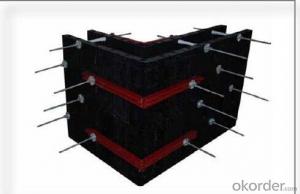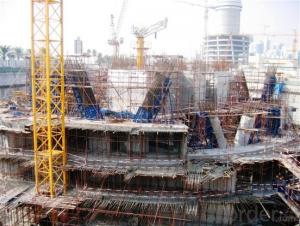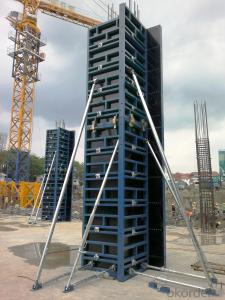Tabel formwork
- Loading Port:
- China Main Port
- Payment Terms:
- TT OR LC
- Min Order Qty:
- -
- Supply Capability:
- -
OKorder Service Pledge
Quality Product, Order Online Tracking, Timely Delivery
OKorder Financial Service
Credit Rating, Credit Services, Credit Purchasing
You Might Also Like
Tabel Formwork:
Table formwork is the most typical application for slab, with timber beam, the slab formwork is
light weight, fast and economic in the construction.
Characteristics:
◆ Simple structure, easy assembly.
◆ Flexible structure, be adapted to different support system.
◆ High construction efficiency with special system tools.
1. Lifting fork for lifting the table formwork to upper floor.
2. Trolley for moving the table formwork on floor.
◆ Flexible application with stand alone props.
◆ Safer condition with handrails.
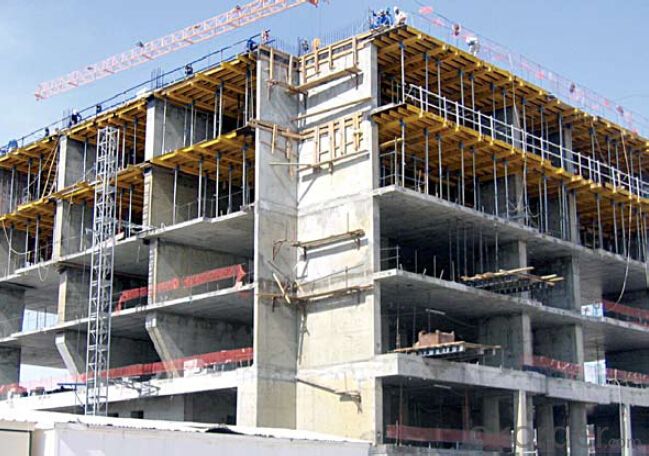
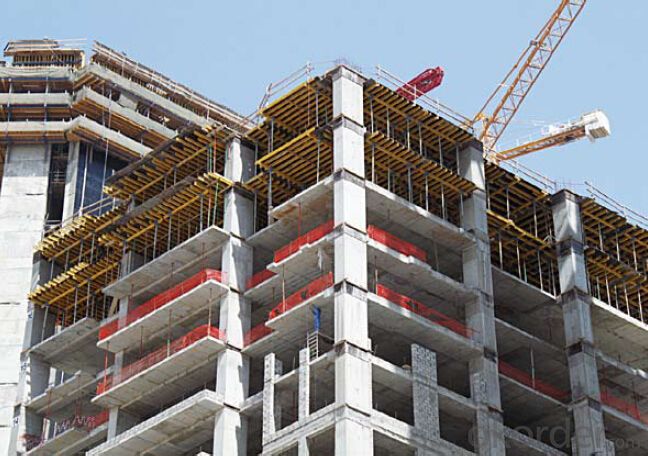

- Q:How does steel frame formwork accommodate for different concrete reinforcement configurations?
- Steel frame formwork is a versatile system that can easily accommodate different concrete reinforcement configurations. The frame is adjustable and can be customized to fit various reinforcement layouts. Additionally, the formwork allows for easy placement and adjustment of reinforcement bars, ensuring they are properly positioned within the concrete structure. This flexibility makes steel frame formwork a preferred choice for construction projects with varying reinforcement configurations.
- Q:What types of construction projects are steel frame formwork commonly used for?
- Steel frame formwork is commonly used for a variety of construction projects that require the construction of reinforced concrete structures. Some examples of construction projects where steel frame formwork is commonly used include: 1. High-rise buildings: Steel frame formwork is often used in the construction of high-rise buildings, as it provides a strong and durable framework for the concrete structure. 2. Bridges: Steel frame formwork is also commonly used in the construction of bridges, as it can withstand the heavy loads and provide the necessary support for the concrete components. 3. Industrial structures: Steel frame formwork is frequently utilized in the construction of industrial structures such as factories, warehouses, and power plants. The steel frame formwork allows for the construction of large and complex concrete structures, which are often required in industrial settings. 4. Infrastructure projects: Steel frame formwork can be found in various infrastructure projects such as tunnels, dams, and water treatment plants. These projects often involve the construction of large-scale concrete structures that require a strong and reliable formwork system. 5. Residential buildings: Steel frame formwork is also used in the construction of residential buildings, especially those with multiple stories. The steel frame provides stability and ensures the structural integrity of the building during and after the construction process. Overall, steel frame formwork is a versatile and widely used construction technique that is commonly employed in various construction projects where reinforced concrete structures are required.
- Q:What are the quality control measures for steel frame formwork production?
- The quality control measures for steel frame formwork production include inspection and testing of raw materials, such as steel bars and plates, to ensure they meet the required specifications and standards. Additionally, the welding and fabrication processes are closely monitored to ensure proper adherence to design specifications and to prevent any defects or structural weaknesses. Regular inspections and measurements are conducted during the manufacturing process to verify dimensional accuracy and to identify any potential issues. Finally, comprehensive testing and quality checks are performed on the finished steel frame formwork to assess its strength, durability, and overall performance.
- Q:What is the lifespan of a steel frame formwork system?
- The lifespan of a steel frame formwork system can vary depending on factors such as maintenance, usage, and environmental conditions. However, with proper care and regular maintenance, a steel frame formwork system can last for several decades.
- Q:What are the key considerations for selecting the appropriate steel frame formwork system for projects with limited construction budgets?
- When selecting an appropriate steel frame formwork system for projects with limited construction budgets, there are several key considerations that need to be taken into account. These considerations include: 1. Cost-effectiveness: The primary concern for projects with limited construction budgets is to ensure that the chosen steel frame formwork system is cost-effective. This means selecting a system that provides the necessary functionality and durability at an affordable price. It is important to compare different options and consider both the upfront cost and the long-term maintenance costs. 2. Flexibility and reusability: Another important consideration is the flexibility and reusability of the steel frame formwork system. Projects with limited budgets often require the formwork system to be used for multiple concrete pours or across different projects. Therefore, selecting a system that can be easily adapted and reused saves both time and money in the long run. 3. Durability and quality: While cost-effectiveness is crucial, it is equally important to ensure that the steel frame formwork system is durable and of high quality. Low-quality formwork systems may result in additional costs due to frequent repairs or replacements. Therefore, it is important to select a system that is built to withstand the demands of the project and will not compromise safety or structural integrity. 4. Ease of assembly and disassembly: Projects with limited budgets often require efficient construction processes to save time and labor costs. Therefore, selecting a steel frame formwork system that is easy to assemble and disassemble is essential. This will not only enable faster construction but also reduce the need for specialized labor, ultimately saving money. 5. Availability and accessibility: It is important to consider the availability and accessibility of the chosen steel frame formwork system. Projects with limited budgets may benefit from selecting a system that is readily available in the local market or can be easily sourced. This will help avoid delays and additional costs associated with importing or acquiring specialized equipment. In conclusion, when selecting an appropriate steel frame formwork system for projects with limited construction budgets, cost-effectiveness, flexibility, durability, ease of assembly, and availability are key considerations. By carefully evaluating these factors, project managers can make informed decisions that optimize the use of resources and ensure successful project outcomes within the budget constraints.
- Q:What are the different types of supports and props used with steel frame formwork?
- There are several types of supports and props that are commonly used with steel frame formwork systems. These supports and props play a crucial role in providing stability and support to the formwork, ensuring that the concrete structure is properly formed and maintained during the construction process. Some of the different types of supports and props used with steel frame formwork include: 1. Adjustable Steel Props: These are telescopic steel tubes that can be adjusted to different lengths. They are commonly used to support horizontal formwork elements such as beams and slabs. The adjustable feature allows for easy height adjustment and ensures stability during concrete pouring. 2. Tripod Supports: Tripod supports consist of three legs with adjustable heights. They are used to support vertical formwork elements such as columns and walls. Tripod supports provide stability and are easily adjustable to accommodate different formwork heights. 3. Soldier Props: Soldier props are vertical supports that are commonly used to support vertical formwork elements such as walls. They are typically made of steel and are adjustable in height. Soldier props provide stability and are often used in conjunction with other supports for added reinforcement. 4. Scaffolding: Scaffolding is a temporary structure that is used to support workers and materials during construction. It is often used in conjunction with steel frame formwork systems to provide additional support and access to different areas of the structure. Scaffolding is typically made of steel or aluminum and can be easily assembled and disassembled. 5. Formwork Brackets: Formwork brackets are used to support horizontal formwork elements such as beams and slabs. They are typically attached to the structure using bolts or clamps and provide additional support and stability during concrete pouring. Formwork brackets are often adjustable to accommodate different formwork heights and configurations. 6. Wall Ties: Wall ties are used to hold formwork panels together and provide stability to vertical formwork elements such as walls. They are typically made of steel and are secured to the formwork panels using nuts and bolts. Wall ties ensure that the formwork panels remain in place during concrete pouring and curing. Overall, the different types of supports and props used with steel frame formwork systems are designed to provide stability, support, and flexibility during the construction process. These supports and props are essential in ensuring that the formwork remains in place, allowing for the proper formation of concrete structures.
- Q:Can steel frame formwork be used in projects with restricted material availability?
- Steel frame formwork can be a suitable option for projects with restricted material availability. The use of steel frame formwork offers several advantages in such situations. Firstly, steel is a durable and robust material that can withstand harsh conditions and heavy loads, making it suitable for various construction projects. Additionally, steel formwork can be reused multiple times, reducing the need for frequent material replacements. This feature is particularly beneficial in projects with limited access to construction materials. Moreover, steel frame formwork can be easily transported and assembled, allowing for efficient construction even in areas with restricted material availability. Overall, the use of steel frame formwork can be a practical solution for projects with limited material resources, ensuring cost-effectiveness and timely completion.
- Q:What are the different types of corner profiles used with steel frame formwork?
- Steel frame formwork systems commonly utilize various types of corner profiles to enhance stability and support. These profiles maintain the formwork's position and enable it to withstand the concrete's pressure. One frequently utilized corner profile is the L-shaped variant, which is typically composed of steel and possesses a 90-degree angle. Its purpose is to reinforce and support the formwork at its corners. By evenly distributing the load, the L-shaped corner profile prevents weak points or bending. Similarly, the T-shaped corner profile, also made of steel, is another option. Its design provides additional strength and stability to the formwork's corners. This profile effectively prevents any potential movement or shifting during the concrete pouring process, ensuring secure placement. Moreover, adjustable corner profiles are available for steel frame formwork systems. These profiles can be modified to different angles, allowing for flexibility in formwork design. They prove particularly beneficial in handling irregular shapes or creating angled corners. To sum up, steel frame formwork systems employ L-shaped corner profiles, T-shaped corner profiles, and adjustable corner profiles. These profiles play a crucial role in ensuring stability, reinforcement, and support for the formwork system, guaranteeing its durability and effectiveness during the concrete pouring process.
- Q:What is the steel frame center support structure
- Steel structure and concrete structure, masonry structure, wood structure and so on, to the composition of the material structure.
- Q:Can steel frame formwork be used for both straight and curved slabs?
- Yes, steel frame formwork can be used for both straight and curved slabs. The steel frames can be easily adjusted to create the desired shape and can withstand the pressure of concrete, making it a versatile option for various slab designs.
1. Manufacturer Overview |
|
|---|---|
| Location | |
| Year Established | |
| Annual Output Value | |
| Main Markets | |
| Company Certifications | |
2. Manufacturer Certificates |
|
|---|---|
| a) Certification Name | |
| Range | |
| Reference | |
| Validity Period | |
3. Manufacturer Capability |
|
|---|---|
| a)Trade Capacity | |
| Nearest Port | |
| Export Percentage | |
| No.of Employees in Trade Department | |
| Language Spoken: | |
| b)Factory Information | |
| Factory Size: | |
| No. of Production Lines | |
| Contract Manufacturing | |
| Product Price Range | |
Send your message to us
Tabel formwork
- Loading Port:
- China Main Port
- Payment Terms:
- TT OR LC
- Min Order Qty:
- -
- Supply Capability:
- -
OKorder Service Pledge
Quality Product, Order Online Tracking, Timely Delivery
OKorder Financial Service
Credit Rating, Credit Services, Credit Purchasing
Similar products
New products
Hot products
Related keywords




















